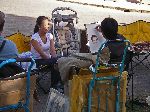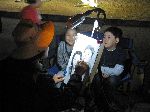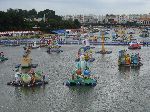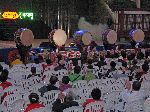Ibike Korea People-to-People Program
 Photo essay: Jinju
Photo essay: Jinju
Jinju is a gem of a
city, rich in culture and history.
Points of Interest: Jinju Castle, museum, antique district, (Jinju Namgang Yudeung
Festival (Oct))
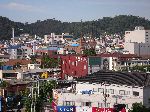
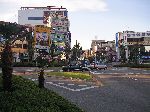 The
old section of Jinju City, between the
Namgong River and hills, is built on a very human scale and, with the
exception of a couple of big roads, is a very people-friendly and
bicycle-friendly city.
The
old section of Jinju City, between the
Namgong River and hills, is built on a very human scale and, with the
exception of a couple of big roads, is a very people-friendly and
bicycle-friendly city.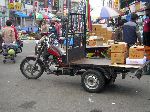
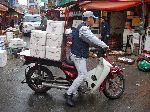 Transporting large
quantities of goods through the narrow streets of the market is difficult so
specialized solutions have been developed. In some case traditional "A"
framed backpacks are the only tool that is practical.
Transporting large
quantities of goods through the narrow streets of the market is difficult so
specialized solutions have been developed. In some case traditional "A"
framed backpacks are the only tool that is practical.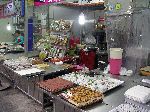
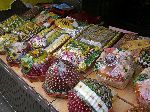 Sweets for sale in the
market, Jinju.
Sweets for sale in the
market, Jinju.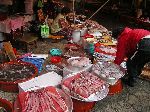
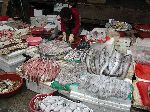 Fish mongers in the market,
Jinju.
Fish mongers in the market,
Jinju.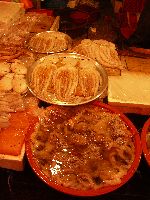
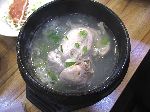

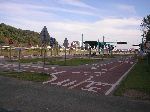
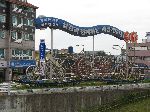 Part of the riverside
trail facility in Jinju is this bicycle safety awareness course for kids.
It incorporates a variety of intersections, signs, signals, stripping, curb
penetrations and traffic situations.
Part of the riverside
trail facility in Jinju is this bicycle safety awareness course for kids.
It incorporates a variety of intersections, signs, signals, stripping, curb
penetrations and traffic situations.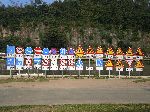
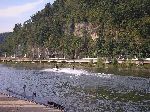
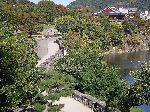
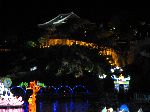 Chokseongnu (pavilion), Jinjuseong (Castle or
fortress), served as a military command post in times of war and as a place of
entertainment in times to peace. It was first constructed in 1241. It is
in the upper right corner of the photo to the left. The photo to
the right was taken at night and the roof line is lit.
Chokseongnu (pavilion), Jinjuseong (Castle or
fortress), served as a military command post in times of war and as a place of
entertainment in times to peace. It was first constructed in 1241. It is
in the upper right corner of the photo to the left. The photo to
the right was taken at night and the roof line is lit.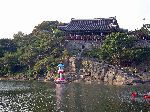
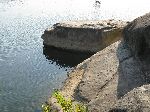
 In the
foreground (left photo) is Uiam (rock of patriotism). The name
commemorates the actions of the city hero Nongae, a local gisaeng (professional
female entertainer). The legend goes that when Jinjuseong fell to the
Japanese army (1593), Nongae (lower right photo) allured the Japanese commander to Uiam Rock and
martyred herself by grabbing him and jumping into the river -- drowning the
commander, as well as herself. A stylized Nongae is the mascot of the city
(right).
In the
foreground (left photo) is Uiam (rock of patriotism). The name
commemorates the actions of the city hero Nongae, a local gisaeng (professional
female entertainer). The legend goes that when Jinjuseong fell to the
Japanese army (1593), Nongae (lower right photo) allured the Japanese commander to Uiam Rock and
martyred herself by grabbing him and jumping into the river -- drowning the
commander, as well as herself. A stylized Nongae is the mascot of the city
(right).
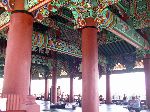
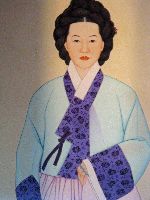 Jinjuseong is a fortified highland along the Namgang River which dates back
to the Three Kingdoms era, and is the focal point of Jinju history, especially
during the Imjinwaeran (Japanese Invasion, 1592-98), but it chronicles a lot of
Jinju history up through the Joseon period.
Jinjuseong is a fortified highland along the Namgang River which dates back
to the Three Kingdoms era, and is the focal point of Jinju history, especially
during the Imjinwaeran (Japanese Invasion, 1592-98), but it chronicles a lot of
Jinju history up through the Joseon period.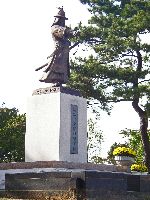
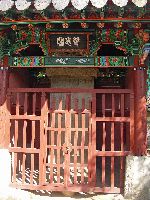
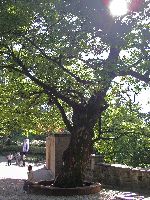
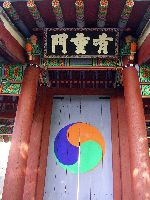
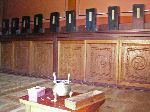 Changyeolsa Shrine was
built in 1595 to enshrine the memorial tablets of the patriots who died in
action during the 2nd Jinju Battle in 1593. The tablet of Kim Simin
and 39 other patriots are enshrined here.
Changyeolsa Shrine was
built in 1595 to enshrine the memorial tablets of the patriots who died in
action during the 2nd Jinju Battle in 1593. The tablet of Kim Simin
and 39 other patriots are enshrined here.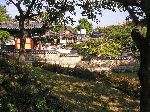
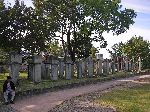
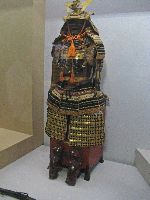
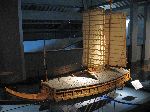 Within
Jinjuseong is the Jinju National Museum. The museum has a very interesting
exhibit on the Imjinwaeran (Japanese Invasion, 1592-98), its
Within
Jinjuseong is the Jinju National Museum. The museum has a very interesting
exhibit on the Imjinwaeran (Japanese Invasion, 1592-98), its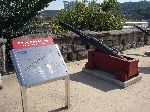 main focus, made up of a variety of art media, artifacts and displays.
There is also an exhibit on ceramics and porcelain.
main focus, made up of a variety of art media, artifacts and displays.
There is also an exhibit on ceramics and porcelain.
Outside, around the Jinjuseong other replicas are displayed. The piece shown here is a Super Chongtong missile and launcher from the Joseon period.
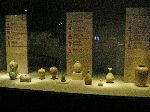
It is interesting that in the initial stages of the Imjinwaeran the Japanese captured Korean artisans and scholars as a "technology transfer" to Japan. This allowed Japan to quickly advance their porcelain industry, printing culture and neo-Confucius scholarship. Laborers were also captured to fill its depleted labor force. Later in the occupations Koreans -- males and females, young and old -- were being captured and sold to Portuguese traders. Estimates on the number of slaves taken range from 20,000 to 100,000 and higher.
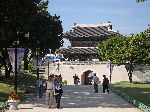
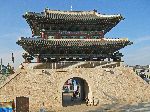 Gongbukmun (gate). Its name consists of three
meaningful characters: Gong putting your hands together and lifting them to your
chest in reverence; Buk, north, the direction from Jinju to the residence of the
King; and, Mun, Moon gate.
Gongbukmun (gate). Its name consists of three
meaningful characters: Gong putting your hands together and lifting them to your
chest in reverence; Buk, north, the direction from Jinju to the residence of the
King; and, Mun, Moon gate.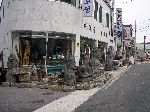
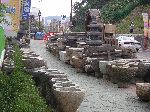
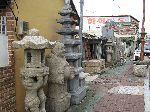
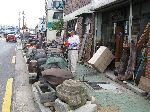 Just
outside of Gongbukmun is Insa-dong Antique Street, Jinju. Stretched along
several blocks, vendors display their large inventory of all
sizes and shapes of stone,
ceramic, bronze, silver, wood, lacquer, inlayed, screens, etc.
Just
outside of Gongbukmun is Insa-dong Antique Street, Jinju. Stretched along
several blocks, vendors display their large inventory of all
sizes and shapes of stone,
ceramic, bronze, silver, wood, lacquer, inlayed, screens, etc.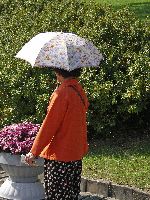
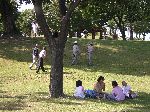 Beside
its historical significance and position as a cultural repository, the castle is
also a popular place to Jinjuites to relax as well. People picnic, stroll,
relax in the several pavilions, their are music venues, cultural events and you
can have your portrait painted -- day or night. It is the "Grand Central Park" of Jinju.
Beside
its historical significance and position as a cultural repository, the castle is
also a popular place to Jinjuites to relax as well. People picnic, stroll,
relax in the several pavilions, their are music venues, cultural events and you
can have your portrait painted -- day or night. It is the "Grand Central Park" of Jinju.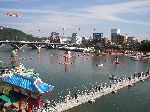
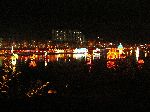 In
early October, Jinju hosts an annual Namgang Yudeung (Lantern) Festival. If it is at
all practical to visit Jinju during the Festival don't pass up the opportunity.
In
early October, Jinju hosts an annual Namgang Yudeung (Lantern) Festival. If it is at
all practical to visit Jinju during the Festival don't pass up the opportunity.The festival is most active, energized, and lighted from 6pm to midnight. Each year it seems to get larger and more elaborate.
The floating lantern festival has its origins in the period of the Japanese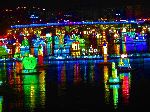 Invasion. With only 3,800 troops, Gen Kim Si-min's army killed 20,000 Japanese
in October 1592, repelling the first invasion. During the invasion the
general raised lanterns in the sky and floated lanterns on the river to send
military signals to loyal troops and other supporters outside of the castle.
Invasion. With only 3,800 troops, Gen Kim Si-min's army killed 20,000 Japanese
in October 1592, repelling the first invasion. During the invasion the
general raised lanterns in the sky and floated lanterns on the river to send
military signals to loyal troops and other supporters outside of the castle.
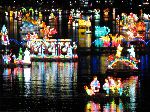
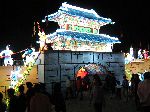
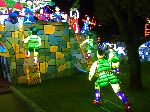 At night the floats/lanterns on the
river and land are lit
and there is music, food, games, vendors and a carnival atmosphere along both sides of
the Namgang River. A lot of the lanterns depict historical events -- complete
with bloody combatants, where appropriate. There are also floats for Korea
folklore, sports and international icons (i.e. Statue of Liberty, Eiffel Tower,
etc.) The white heron is the Jinju bird.
At night the floats/lanterns on the
river and land are lit
and there is music, food, games, vendors and a carnival atmosphere along both sides of
the Namgang River. A lot of the lanterns depict historical events -- complete
with bloody combatants, where appropriate. There are also floats for Korea
folklore, sports and international icons (i.e. Statue of Liberty, Eiffel Tower,
etc.) The white heron is the Jinju bird.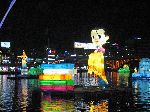
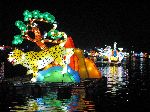
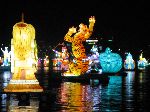
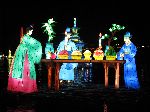
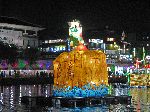
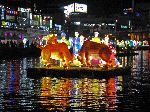
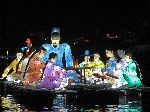
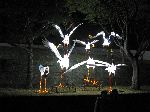
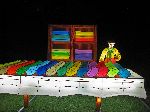
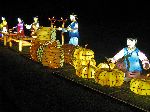
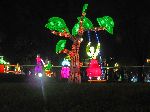
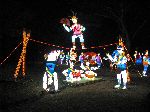
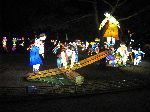
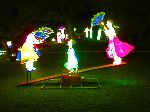
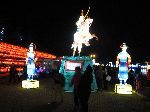
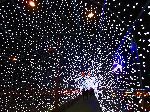
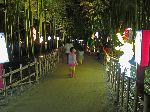
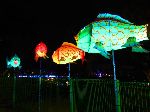


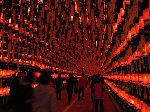
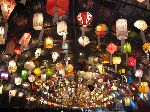 More
personal size lanterns are also part of the event. Individuals and
businesses that want to support the festival can by a red lantern for 10,000 won
and make a dedication. These are hung on a long arched structure that
forms a tunnel of lanterns several hundred meters long. The are also
opportunities to express your personal creativity by designing and making your
own personal lantern. Some of these were legitimate works of art.
More
personal size lanterns are also part of the event. Individuals and
businesses that want to support the festival can by a red lantern for 10,000 won
and make a dedication. These are hung on a long arched structure that
forms a tunnel of lanterns several hundred meters long. The are also
opportunities to express your personal creativity by designing and making your
own personal lantern. Some of these were legitimate works of art.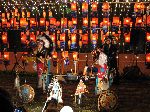
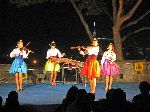 There were stages on both sides of the
river with a variety of Korean and foreign music from elsewhere in Asia, Europe,
Africa and the Americas. One group the raise eyebrows was an Andean
pan-pipe group wearing North American plains Indian headdresses (left). On
another stage Korean women, playing a mix of traditional and modern instruments
jazzed up a variety of tradition, folk and modern melodies.
There were stages on both sides of the
river with a variety of Korean and foreign music from elsewhere in Asia, Europe,
Africa and the Americas. One group the raise eyebrows was an Andean
pan-pipe group wearing North American plains Indian headdresses (left). On
another stage Korean women, playing a mix of traditional and modern instruments
jazzed up a variety of tradition, folk and modern melodies.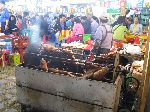
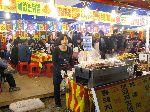 An
event would be an event without food the Namgang Yudeung Festival is no
exception. Besides typical Korean snack food there is pigs roasting on a
spit, mandu, corn on the cob, ice cream, sweets and soup shops.
An
event would be an event without food the Namgang Yudeung Festival is no
exception. Besides typical Korean snack food there is pigs roasting on a
spit, mandu, corn on the cob, ice cream, sweets and soup shops.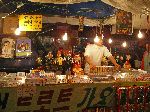
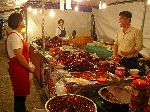
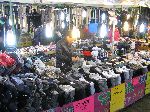
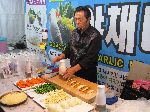 Lots
of people and bright lights, you can imagine that the carnival vendors are in
attendance as well. There are knife sellers, chop-o-matic sellers, mega
socks shops, kimchi vendor, dollar stores, silk booths, leather goods, toy
stores, lingerie and the list could go on. Don't forget the games of
chance (darts at a balloon, rings over a bottle, ball in the basket) where if
you spend enough and are also lucky you can take home and oversized stuffed
animals -- this arrangement seemed to be most attractive with teenage boys with
dates to give any booty too.
Lots
of people and bright lights, you can imagine that the carnival vendors are in
attendance as well. There are knife sellers, chop-o-matic sellers, mega
socks shops, kimchi vendor, dollar stores, silk booths, leather goods, toy
stores, lingerie and the list could go on. Don't forget the games of
chance (darts at a balloon, rings over a bottle, ball in the basket) where if
you spend enough and are also lucky you can take home and oversized stuffed
animals -- this arrangement seemed to be most attractive with teenage boys with
dates to give any booty too.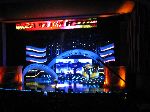
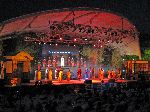 Part of the Namgang Yudeung (Lantern)
Festival is the Korea Drama Festival. It has several venues and multiple
events. The photo to the left is of a competition akin to Korea Has (Drama) Talent.
Each of the contest performed two short dramatic piece of a highly contrasting
nature. They were then judged and the winners moved on to the next round.
The photo on the right is a historical drama set at the time of the Japanese
invasion and Korean resistance.
Part of the Namgang Yudeung (Lantern)
Festival is the Korea Drama Festival. It has several venues and multiple
events. The photo to the left is of a competition akin to Korea Has (Drama) Talent.
Each of the contest performed two short dramatic piece of a highly contrasting
nature. They were then judged and the winners moved on to the next round.
The photo on the right is a historical drama set at the time of the Japanese
invasion and Korean resistance.
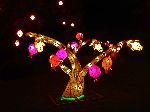 The historical drama was precede by a Cheondong drumming performance.
Cheondong is very similar to Japanese Taiko drumming. Cheondong (천둥)
translates as "thunder."
The historical drama was precede by a Cheondong drumming performance.
Cheondong is very similar to Japanese Taiko drumming. Cheondong (천둥)
translates as "thunder."
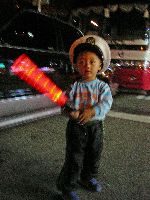
The week-long Namgang Yudeung Festival is filled with events and ceremonies. On one visit we arrived for the parade.
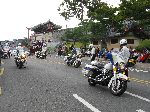
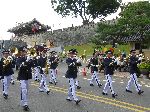 Here
you can see for yourself:
Here
you can see for yourself:The parade started normally enough with a police motorcycle escort and a marching band.

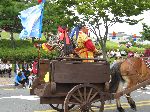
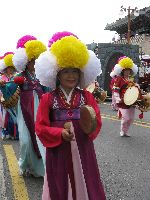
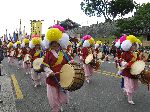

The next section was cultural. First a horse and cart that didn't have a specific purpose to our eyes. This was followed by an all woman traditional Korean drum and gong band. The next contingents like they might be the

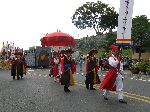
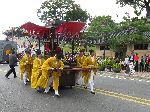

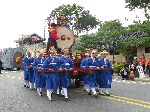
civil and military officials from an Joseon emperor's court, followed by the king, himself, in a rolled throne, with an entourage. This would make the drum that followed the royal drum.
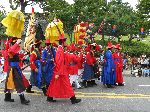
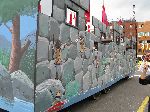
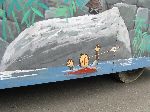
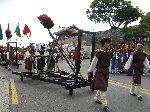
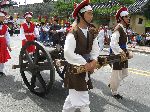
There was another contingent of traditional dressed gentlemen. The theme then moved into the defense of Jinju. There was a float depicting the Japanese attacking the Castle. Most of the attackers had very bloody arrow wounds. This would have been the first Battle of Jinju, which the defender won, despite being many times out numbered.
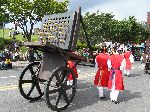
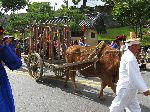
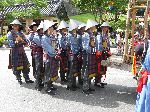
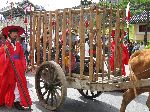
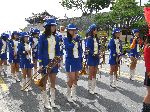
With the battle victory they showed off their weapons (catapults, canons, and rocket launchers) and captured prisoners both in barred carts and walking tied together. On their heels was an all girl band in mini-skirts. I lost track of the connection here. The distraction didn't last long.

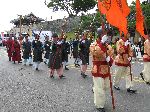
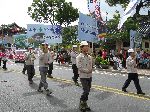
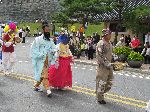

The next contingents were back in period dress. The first perhaps being the civil elite of the victorious Jinju, followed by military brass. The next group looked like they might be introducing the development and commerce theme, but first a few more traditional entries including a company of fan dancers.
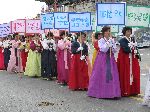 The
signs the women are carrying list various projects the city is pursuing:
Hosting investments by large business; expanding sporting facilities;
establishing a home-decoration park, building environment-friendly roads
etc.
The
signs the women are carrying list various projects the city is pursuing:
Hosting investments by large business; expanding sporting facilities;
establishing a home-decoration park, building environment-friendly roads
etc.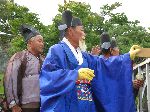
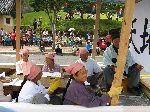
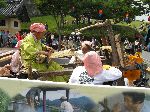
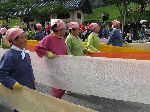
The next theme that I could pick out was about adult literacy and the weaving of silk.

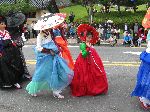
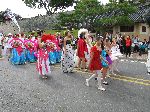
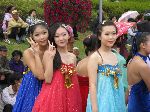
The next couple groups were mostly girls and women, first in historic dress and then what looked to be members of a dance academy including traditional dancers, fan dancers, ballerinas, modern dance and a half dozen guys ready to do some break dancing and street acrobatics.
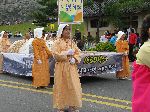
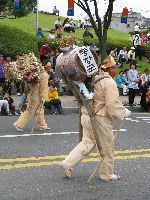
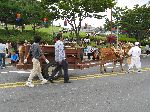
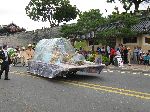
The message of the next phase of the parade was rural development. I started with a float labeled '1950' with a farm on it with a decidedly low yield. The float was followed by men carrying farm produce in tradition back carriers, followed by cows pulling carts. The next float was labeled
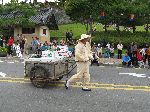
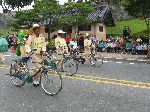
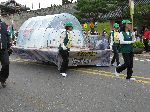
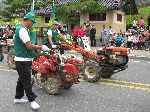
'1960'. The farm it display was a little more robust. The farm produce was being moved by hand pulled carts and the individual transportation was by bicycle. The next float was '1970'. The greenhouse were sturdier and the crop yield was visibly higher. The farmers in this period had walk-behind tractors to help plow the field and transport the produce off the farm. For personal transportation they had motor-cycles. Continuing the pattern the
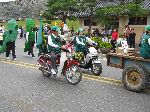
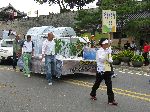
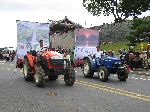
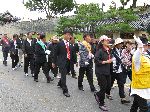
next float was '1980'. The farm was irrigated, the green house was more sophisticated and the output was higher. The farmers were driving fancy tractors to aid them in their work. The display of agriculture progress was followed by contemporarily dressed dignitaries -- perhaps local government officials.
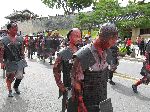 The
last large contingent of the parade depicted bloodied, mangled soldiers.
Perhaps this is a remembrance that the Second Battle of Jinju was lost to
the Japanese and 17,000 soldiers, officials and civilians were massacred.
There was nothing sugar coated about their make-up. It was a
sobering end to the parade.
The
last large contingent of the parade depicted bloodied, mangled soldiers.
Perhaps this is a remembrance that the Second Battle of Jinju was lost to
the Japanese and 17,000 soldiers, officials and civilians were massacred.
There was nothing sugar coated about their make-up. It was a
sobering end to the parade.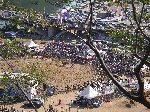
![]() Hadong (South and
West)
Hadong (South and
West)
 Please
contact us if you would like to be added to
Ibike's mailing list or have questions, comments, corrections or criticism. (Also, please let us know how you learned about us and
found this site.) Privacy policy.
Please
contact us if you would like to be added to
Ibike's mailing list or have questions, comments, corrections or criticism. (Also, please let us know how you learned about us and
found this site.) Privacy policy.
![]() IBF Homepage
IBF Homepage ![]() Ibike Programs
Ibike Programs
![]() Ibike Schedule
Ibike Schedule
![]() Search
Search
